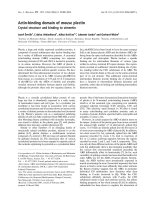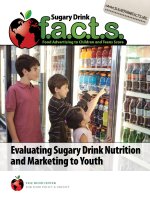Evaluating Fast Food Nutrition and Marketing to Youth pot
Bạn đang xem bản rút gọn của tài liệu. Xem và tải ngay bản đầy đủ của tài liệu tại đây (1.39 MB, 4 trang )
Jennifer L. Harris, Ph.D., M.B.A.
Marlene B. Schwartz, Ph.D.
Kelly D. Brownell, Ph.D.
Evaluating Fast Food Nutrition
and Marketing to Youth
WHY FAST FOOD?
The research is clear: Consuming fast food
endangers young people’s health.
Young people who
eat fast food consume more calories, fat, sugar, and sugar-
sweetened beverages, and less ber, milk, fruit and vegetables
than peers who do not eat fast food.
1
If today’s youth consumed
fast food occasionally, this would not be a public health crisis.
But every day, one-third of American children and adolescents
eat fast food.
2
Fast food contributes 16-17% of adolescents’ total
caloric intake.
3
The fast food industry spent more than 4.2 billion dollars in 2009
to advertise their products to all audiences.
4
They are marketing
to children and teens more than ever – exposure to fast food
ads on TV increased by 21% for preschoolers, 34% for children
(2-11), and 39% for teens (12-17) from 2003 to 2009. Marketing
goes far beyond television ads. The companies use websites,
banner ads, and social and mobile media to reach young people.
The White House Task Force on Childhood Obesity
states that restaurants “have an important role to play
in
creating a food marketing environment that supports, rather than
undermines, the efforts of parents and other caregivers to encourage
healthy eating among children and prevent obesity.”
5
The restaurant industry response: The two largest
fast food advertisers to children,
McDonald’s and Burger
King, have joined the Children’s Food and Beverage Advertising
Initiative (CFBAI) pledging to advertise only “better-for-you” choices
to children,
6
and the majority of restaurants have introduced some
more nutritious options to their menus.
7
But critical questions remain: Are these actions
having a positive impact?
Or, does the sheer volume of
marketing for restaurants’ least nutritious options eclipse any
positive efforts?
Restaurant 2009 ad spend
(in millions)
Ages
2-5
Ages
6-11
Ages
12-17
McDonald’s $898.1 309 368 284
Subway $424.6 97 127 177
Wendy’s $282.6 46 58 113
Burger King $281.6 152 185 189
KFC $268.9 62 78 146
Taco Bell $243.4 50 69 140
Pizza Hut $221.8 54 69 125
Sonic $185.1 27 37 68
Domino’s $180.8 35 46 85
Dunkin’ Donuts $120.9 11 15 28
Dairy Queen $77.6 20 27 48
Starbucks $28.9
All fast food $4,217.7 1,021 1,272 1,723
Source: The Nielsen Company (2010)
Fast food ads
viewed in 2009
THE RESTAURANTS IN THIS STUDY
Fast Food FACTS provides comprehensive and science-based
information about fast food marketing practices and young people’s
fast food purchases. This study documents, in detail, the menu
items offered and sold in fast food restaurants and how they are
marketed to youth.
Menu composition – Nutrient content and comparison
of all menu items offered as of January 2010 at the 12 largest
restaurants in sales and marketing to youth.
External advertising – Data measures how restaurants
pull customers inside. Includes syndicated data from The Nielsen
Company (Nielsen), comScore Inc., and Arbitron Inc. on ad spending
and youth exposure to ads on TV, radio and internet, and analyses of
the content of these ads and social, viral and mobile marketing.
In-store marketing – Documents how restaurants push sales
of individual menu items inside the restaurants. Research includes
an audit of more than 1,000 restaurants nationwide to measure
in-store signs and pricing, and a study of the items offered by
restaurant employees when customers order kids’ meals and
combo meals.
Marketing outcomes – Measures the effectiveness of
these marketing strategies, using data from The NPD Group’s
CREST service on menu item purchases and a survey of parents
to measure frequency of visits to top fast food restaurants with
their children, what they buy, and why.
THE ANALYSES
How healthy are fast food meals?
• Only 12 of 3,039 possible kids’ meal combinations meet
nutrition criteria for preschoolers. Only 15 meet nutrition
criteria for older children.
• Teens between the ages of 13 and 17 purchase 800 to 1,200
calories in an average fast food meal, including 30% or more of
calories from sugar and saturated fat.
• At most restaurants, young people purchase one-half or more of
their maximum daily recommended sodium intake in just one meal.
Fries and sugary beverages are the order of the day.
Researchers ordered kids’ meals at 250 fast food restaurants across
the country to nd out how often restaurant employees offer healthy
beverage and side dish options at the point-of-sale.
• At McDonald’s, Burger King, Wendy’s and Taco Bell, employees
automatically served french fries or another unhealthy side
more than 84% of the time. A soft drink or other unhealthy
beverage was served at least 72% of the time.
• Subway was the sole exception, offering healthy sides and
beverages 60% of the time.
When are teens eating fast food?
• Teens order more fast food than any other age group during
non-meal times, after school and in the evening.
8
• Snacks and desserts often marketed directly to teens
contain as many as 1,500 calories, which is ve times more
than the American Dietetic Association’s recommendation of
a 200-300 calorie snack for active teens.
9
Has the youth marketing landscape improved?
The fast food industry continues to relentlessly market to youth.
• The average preschooler (2-5) sees almost three ads per day for fast
food; children (6-11) see three-and-a-half; and teens see almost ve.
• Children’s exposure to fast food TV ads is increasing, even
for ads from McDonald’s and Burger King, who have pledged to
reduce unhealthy marketing to children. Compared with 2007,
in 2009 children (6-11) saw 26% more ads for McDonald’s,
10% more for Burger King, and 59% more for Subway.
• Children see more than just ads intended for kids. More than
60% of fast food ads viewed by children (2-11) were for
foods other than kids’ meals.
Youth-targeted marketing has spread to company
websites, social networks and other digital media.
• Web-based targeting starts as young as age 2 through
websites such as McDonalds’ Ronald.com.
• McDonald’s and Burger King have created sophisticated
advergames and virtual worlds to engage children (e.g.,
McWorld.com, HappyMeal.com, and ClubBK.com).
• McDonalds’ 13 websites get 365,000 unique child visitors
and 294,000 unique teen visitors each month.
• Nine restaurant Facebook pages had more than one million fans,
and Starbucks’ page boasted more than 11.3 million in July 2010.
• Eight of the fast food chains have smartphone apps to reach
young consumers anytime, anywhere.
Fast food marketing targets vulnerable groups –
often with less healthy items.
• Hispanic preschoolers see 290 Spanish-language fast food
TV ads each year and McDonald’s is responsible for one-quarter
of young people’s exposure to Spanish-language fast food
advertising.
• African American children and teens see at least 50% more
fast food ads than their white peers. McDonald’s and KFC
specically target African American youth with TV advertising,
targeted websites, and banner ads.
• Taco Bell targets teens in its TV and radio advertising. Dairy
Queen, Sonic and Domino’s target teens with ads for their desserts
and snacks, and Burger King advertises teen-targeted promotions.
RESULTS
Source: The Nielsen Company (ad exposure data) and TV ad nutrition analysis
Calories Viewed Per Day
White African
American
White African
American
Ages 2–11 Ages 12–17
3,500
3,000
2,500
2,000
1,500
1,000
500
0
CALORIES VIEWED DAILY IN FAST FOOD TV ADS
■ Dairy Queen, Dunkin’
Donuts, Sonic,
Starbucks & Wendy’s
■ Domino’s
■ Burger King
■ Subway
■ McDonald’s
■ KFC, Pizza Hut &
Taco Bell (YUM!
Brands)
RECOMMENDATIONS
Fast food restaurants must do more to develop
and promote lower calorie and more nutritious
menu items.
• Restaurants must increase the number of healthy items
on their menus.
• Popular items should be reformulated to decrease the
saturated fat, sodium, and calories in the average entrée.
• Kids’ meal options must be developed to meet the needs of
both the preschoolers and older children who consume them.
Fast food restaurants must establish meaningful
standards for child-targeted marketing that
apply to all fast food restaurants — not just
those who voluntarily participate in the CFBAI.
• Nutrition criteria for foods presented in child-targeted
marketing must apply to all kids’ meals served, not just items
pictured in marketing.
• Restaurants must redene “child-targeted” marketing to
include the 60% of TV ads and other forms of marketing
viewed by children but not exclusively targeted to them.
• McDonald’s must stop marketing directly to preschoolers
who are too young to have the capability to resist or question
marketing efforts.
Young people must
consume less of
the calorie-dense
nutrient-poor foods
served at fast food
restaurants.
Fast food restaurants
must drastically change
their current marketing
practices so that
children and teens do
not receive continuous
encouragement to
seek out food that is
ultimately, and severely,
damaging their health.
1 Young, L.R. & Nestle, M. (2003); Sabastian, R. S., Enns, C.W., & Goldman, M.A. (2009); French, S.A., Story, M., Neumark-Sztainer, D., Fulkerson, J.A., & Hannan, P. (2001); Bowman, S.A., Gortmaker,
S.L , Ebbeling, C.B., Pereira, M.A., & Ludwig, D.S. (2004); Nielsen, S.J., Siega-Riz, A.M., & Popkin, B.M. (2002). 2 Bowman et al. 3 Sabastian et al. 4 The Nielsen Company (2010) 5 White House Task
Force on Childhood Obesity (2010). 6 Peeler, Kolish & Enright (2009) 7 National Restaurant Association (2010, September 13). Press release. National Restaurant Association welcomes First Lady Michelle
Obama to speak about “Let’s Move” Initiative. Retrieved from www.restaurant.org/pressroom/pressrelease/?ID=2003 8 The NPD Group/® CREST/Year Ending 2009 9 American Dietetic Association. Smart
Snacking for Adults and Teens. Eat Right: Food, Nutrition, and Health Tips from the American Dietetic Association. Downloaded from www.eatright.org. Accessed October 27, 2010.
Fast food restaurants must do more to
push their lower calorie and more nutritious
menu items inside the restaurants when
young people and parents make their nal
purchase decisions.
• Healthier sides and beverages must be the default option
when ordering kids’ meals. Parents can request the
french fries and soft drink if they want, but parents – not
restaurants – should make that decision. McDonald’s
claims that they sell millions of Happy Meals. Simply
making the default option the healthy option would reduce
children’s consumption by billions of calories per year.
• The smallest size and most healthy version should be
the default option for all menu items.
• Portions of menu items that come in different sizes
(e.g., small, medium, and large) should be consistent
across restaurants.









